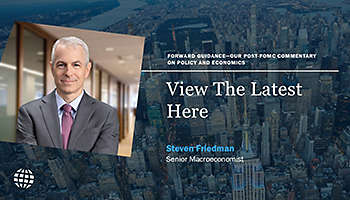Overview
Overview
Our team provides research and analytical support to investment and distribution teams at MacKay. We focus on fixed income and multi-asset solutions while using our platform to drive collaboration and engagement at MacKay through research and project-oriented work.
Macro & Quantitative Solutions Team
Macro & Quantitative Solutions Team

Formally formed in 2021, the team brings together extensive experience and a curious, direct, quantitative, and above all, collaborative approach.
“Research is a process of exploration to gain understanding. It's not enough to know ‘what’; we want to know ‘why’”—Michael DePalma
Insights
Insights

Podcasts and Webcasts
Forward Guidance
Senior Macroeconomist Steven Friedman shares his post-FOMC thoughts on monetary policy and economics. He also meets with portfolio managers mid-cycle to discuss markets and investment opportunities.

January 2, 2025
2025: A Tale of Two Outlooks
2025 should be another year of solid growth for the US economy. A healthy labor market and high levels of household net worth will support consumer spending.

July 25, 2024
A Constructive Base Case, But Politics Inject Uncertainty
Macroeconomic Outlook for 3Q 2024.
July 22, 2024
Forward Guidance - Elections Come Into Focus
Steven & Michael discuss carry environment continuation as easing cycle comes to focus, in relation to housing & investing amidst election uncertainty.

April 16, 2024
Macro Outlook 2Q24
A number of resiliencies should continue to support growth at or above 2% this year. The risk, however, is that a solid year will slow disinflationary impulses.
April 8, 2024
Fixed Income in 2024: Lessons from History
What do points in history, in which yields were similar to recent levels, tell us about the current opportunity set for fixed income?

July 12, 2023
Slouching towards a slowdown
Over the first half of 2023, the US economy exhibited considerable resilience in the face of ongoing monetary tightening.

April 12, 2023
Is the Fed on the Verge of Cutting Rates?
Don’t count on it. The Fed is willing to tolerate labor market pain in order to bring inflation back to target and make sure it stays there.
JANUARY 6, 2023
Recession, Resiliency, and Risks
In his 2023 outlook, Steve Friedman gives his perspective on a possible recession, what best path for a soft landing is, consumer stress, and more.

January 6, 2023
2023 Macroeconomic Outlook
In 2022, the vast majority of developed market central banks significantly tightened policy as they sought to address broad-based inflation.

May 17, 2022
No, Record-High Job Openings Do Not Improve Prospects for a Soft Landing
C. Powell states that the high level of openings can help fine-tune labor demand without a recession.
APRIL 1, 2022
Asset Allocation Discussion
Watch our panel discussion on understanding asset prices, inflation and growth in a structured way.
APRIL 1, 2022
Panel Discussion – Economic Outlook
By year end, GDP growth is likely to slow to its trend rate of about 2%. We expect the Federal Reserve to raise policy rates at every meeting this year.

March 31, 2022
Hard Truths on Soft Landings
In his first speech since the March FOMC meeting, C. Powell noted that the historical record provides “some grounds for optimism” on prospects for a soft landing.

March 23, 2022
The Powell Doctrine: Speak Loudly and Carry a Small Stick
There remains a gap between C. Powell’s tough words on inflation and the Committee’s latest projections.
MARCH 17, 2022
Tougher Talk on Inflation: A Post-FOMC Round Up
We discuss the Fed's growing emphasis on fighting inflation, while also noting how accommodative policy remains.
JANUARY 31, 2022
Out of Patience: A Post-FOMC Round Up
Steven Friedman and Stephen Cianci discuss the Fed's pivot to raising rates, the inflation outlook, and how we're repositioning portfolios.

February 17, 2022
Remaining Constructive on the Outlook
There is reason to worry about inflation and the Fed’s hawkish pivot. But there are also reasons to remain constructive about the outlook. Here are three.
DECEMBER 14, 2021
Macroeconomic Outlook for 2022
Macroeconomic Outlook for 2022

December 3, 2021
Markets are Still Not Pricing in Enough Monetary Policy Tightening
Accelerated asset purchases gives FOMC the option of 3 to 4 quarterly policy rate increases in 2022.

October 15, 2021
Stagflation: How Real Is the Risk?
Recent market chatter about stagflation risk is understandable, given disappointing economic data and continuing price pressures.

